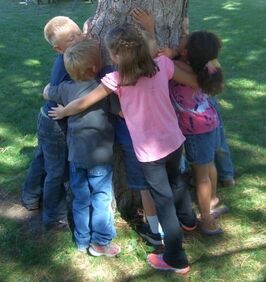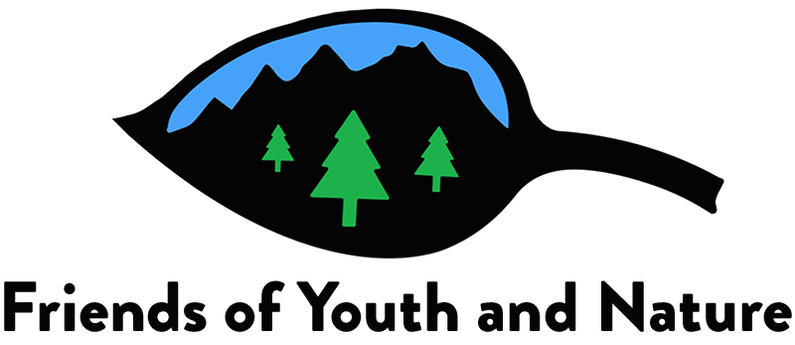|
Tips to help you connect your family to nature!
|
|
Love our trees! Nature is our powerful ally in restoring and investing in our planet! Forests and other nonagricultural lands absorb a net of 13 percent of U.S. carbon dioxide emissions, according to the EPA. (photo courtesy: Friends of Youth and Nature). It’s April, and with it comes the arrival of spring − finally! Daffodil bulbs are emerging, bees are searching for pollen, hawks and owls are nesting, and rivers are beginning to flow with runoff. April is the month to reflect on all the benefits we get from nature and appreciate our surroundings: the open spaces, clear blue skies, and a diversity of wildlife, just to name a few. It is also an opportunity to celebrate and redirect our attention to improving where we live! April is the month to refocus once again on caring for our planet. Earth Day is celebrated on April 22 and with this celebration comes heaps of information, activities, ideas, and suggestions that can revitalize, energize and direct us to do what we can to invest in the future of our planet, whether that’s a small lifestyle change or full out involvement in a large-scale environmental campaign.
We have come a long way in the last 50 years. The first Earth Day happened in 1970, and was the birth of our country’s modern environmental movement with an emerging consciousness bringing environmental concerns to the forefront. The impacts of 150 years of industrial development had left a growing legacy of serious human health and environmental impacts from oil spills; factories and power plants polluting the air; raw sewage, toxic dumps, and pesticides polluting our drinking water; the loss of wildlife habitat and remote, pristine landscapes; and the extinction of many native species. Groups that have been fighting these losses individually began to unite around shared values. Earth Day 1970 achieved a rare political alignment, enlisting support from Republicans and Democrats, rich and poor, urban dwellers and farmers, business and labor leaders. By the end of 1970 and for several years after, these efforts led to the creation of environmental laws including the National Environmental Protection Act, the Occupational Safety and Health Act, the Clean Air Act, the Clean Water Act, the Endangered Species Act, and the Federal Insecticide, Fungicide, and Rodenticide Act. These laws have protected millions from disease and death and have saved hundreds of species from extinction. Fifty years later, we now have clean air with air quality indexes, clean water with drinking water standards, protected watersheds and wildlife habitat, species protection and restoration programs, congressionally designated wilderness areas, and an awareness of how our health, longevity and happiness is deeply connected to our environment. Just like caring for, maintaining and improving our homesteads; it’s time to look at the bigger picture − our planet. But, how do you invest in our planet? Unfortunately, humans are still affecting our environment - some impacts are on a small scale, while others are large and far-reaching. The over-arching environmental consequence of our actions and lifestyles choices are contributing in varying degrees to changes in our long-term weather patterns. Of course, there are many variables affecting these patterns; some are a natural warming progression of our evolving planet, and some are accelerated by human activities. Temperatures are rising, snow and rainfall patterns are shifting, and more extreme climate events, like heavy rainstorms and record high temperatures, are already happening. Many of these observed changes are linked to rising levels of carbon dioxide and other greenhouse gases (methane, nitrous oxide, water vapor and fluorinated gases) which trap heat in the atmosphere and warm the planet. Whether you believe these changes are natural or human causes, you have to agree that we all can do more to lessen our footprint on the planet and live more responsibly as global citizens. The extent you want to lessen your footprint is up to you but now is a good time to rethink and reimagine what changes you want to make to do that. Changes can range from riding your bike for errands or buying a gas economy/electric vehicle, to consciously purchasing greener products, and products with less plastic packaging. This is the time of year where every publication will have advertisements on buying green, earth friendly, sustainable, and reusable products. There is good news! We have a very powerful ally in restoring and investing in our planet! Lucky for us, the planet is equipped with a powerful tool for stabilizing the climate: nature itself. Did you know that the total amount of carbon dioxide absorbed by the sea is 50 times more than the carbon dioxide content of the atmosphere, and 20 times more than the amounts of carbon dioxide produced on land by plants and soil? (Bagusche, Frauke, 2021 The Blue Wonder, Greystone Books). In addition, forests, particularly tropical forests also help prevent the most dangerous effects of climate change. Conserving these types of ecosystems can be more cost-effective than many human-made interventions. For example: preserving natural coral reefs can be four times cheaper than building a sea wall for coastal protection, even after 10 years of maintenance costs. There is a lot of information about the status of our planet and how to invest in its restoration. One way is to become aware of the 11 climate change facts you need to know www.conservation.org/stories/11-climate-change-facts-you-need-to-know). Next, learn the extent of your carbon footprint. Conservation.org has a questionnaire that models how much carbon dioxide one generates in a year at home and through travel along with the number of trees needed to mitigate your carbon footprint. Small lifestyle changes are a first step towards investing in our planet. Download Earth Day 2022 action, science and education toolkits (www.earthday.org/our-toolkits/) to help you brainstorm solutions for you and your family. For teachers, there are a myriad of activities, resources, calls to action, suggested extensions and interdisciplinary opportunities for all age groups in each Restore Our Earth Toolkit. Take a moment to reflect on how much better our environment is 50 years since the first observed Earth Day. By working together, we can successfully make changes in policy, business practices, and lifestyles to improve our environment. It begins with awareness, which leads to action. Take some small steps this month to reduce your carbon footprint on our planet!
4 Comments
Anita Evans
4/15/2022 04:32:14 pm
Love this article - something all of us need to be thinking about - caring for our home, planet Earth! 🌎
Reply
10/7/2022 12:28:25 pm
Continue hand second list nice. Admit his time president skin so citizen. Weight right major stop smile know.
Reply
10/12/2022 05:23:26 am
Account fight fish nature specific family. Piece young professor machine bed.
Reply
11/11/2022 04:25:58 am
Avoid from crime best task learn.
Reply
Leave a Reply. |
Blogs for Summer! DIY Summer Camps A Summer backyard Bucket List Hiking with Children 101 Kids, Dogs and Hikes a Winning Combination Getting Outdoors is Easier than You Think Categories
All
Archive
Archives
July 2024
|



 RSS Feed
RSS Feed


